Elite parts. Airborne Forces - elite troops, or the loud glory of the past
In many armies of the worldberetsindicate that the units using them belong toelite troops. Since they have a special mission, elite units must have something to separate them from the rest. For example, the famous " green beret"is "a symbol of excellence, a sign of valor and distinction in the struggle for freedom."
History of the military beret.
Given the practicality of the beret, its informal use by the European military dates back thousands of years. An example is the blue beret, which became a symbol of the Scottish military in the 16th and 17th centuries. As an official military headdress, the beret began to be used during the War of Succession to the Spanish Crown in 1830 by order of General Tomás de Zumalacárregui, who wanted an inexpensive way to make headdresses resistant to the vagaries of weather in the mountains, easy to care for and for use on special occasions .
Other countries followed suit with the creation of the French Alpine Chasseurs in the early 1880s. These mountain troops wore clothing that included several features that were innovative for the time. Including large berets, which have survived to this day.  Berets have features that make them very attractive to the military: they are cheap, can be made in a wide range of colors, can be rolled up and tucked into a pocket or under shoulder straps, and can be worn with headphones (this is one of the reasons why tankers adopted the beret) .
Berets have features that make them very attractive to the military: they are cheap, can be made in a wide range of colors, can be rolled up and tucked into a pocket or under shoulder straps, and can be worn with headphones (this is one of the reasons why tankers adopted the beret) .
The beret was found particularly useful by armored vehicle crews, and the British Tank Corps (later the Royal Tank Corps) adopted this headgear as early as 1918.
After World War 1, when the issue of official changes to uniforms was considered at high level, General Elles, who was a propagandist of berets, gave another argument - during maneuvers it is comfortable to sleep in a beret and it can be used as a balaclava. After lengthy debate within the Ministry of Defence, the black beret was officially approved by His Majesty's decree of March 5, 1924. The black beret remained the exclusive privilege of the Royal Tank Corps for quite a long time. Then the practicality of this headdress was noticed by others and by 1940 all armored units in Great Britain began to wear black berets. German tank crews in the late 1930s also adopted the beret with the addition of a padded helmet inside. Black has become a popular color for tank crew hats because it doesn't show oil stains.
German tank crews in the late 1930s also adopted the beret with the addition of a padded helmet inside. Black has become a popular color for tank crew hats because it doesn't show oil stains. Second World War gave berets new popularity. English and American saboteurs, who were thrown behind the German lines, in particular to France, quickly appreciated the convenience of berets, especially dark colors - it was convenient to hide their hair under them, they protected their heads from the cold, the beret was used as a balaclava, etc. Some British units introduced berets as the headdress of formations and branches of the military. So, for example, it was with the SAS - Special Aviation Service, a special purpose unit engaged in sabotage and reconnaissance behind enemy lines - they took a sand-colored beret (it symbolized the desert, where the SAS had to work hard against Rommel’s army). British paratroopers chose a crimson beret - according to legend, this color was suggested by the writer Daphne Du Maurier, the wife of General Frederick Brown, one of the heroes of the Second World War. Because of the color of the beret, the paratroopers immediately received the nickname “cherries.” Since then, the crimson beret has become an unofficial symbol of military paratroopers around the world.
Second World War gave berets new popularity. English and American saboteurs, who were thrown behind the German lines, in particular to France, quickly appreciated the convenience of berets, especially dark colors - it was convenient to hide their hair under them, they protected their heads from the cold, the beret was used as a balaclava, etc. Some British units introduced berets as the headdress of formations and branches of the military. So, for example, it was with the SAS - Special Aviation Service, a special purpose unit engaged in sabotage and reconnaissance behind enemy lines - they took a sand-colored beret (it symbolized the desert, where the SAS had to work hard against Rommel’s army). British paratroopers chose a crimson beret - according to legend, this color was suggested by the writer Daphne Du Maurier, the wife of General Frederick Brown, one of the heroes of the Second World War. Because of the color of the beret, the paratroopers immediately received the nickname “cherries.” Since then, the crimson beret has become an unofficial symbol of military paratroopers around the world.  The first use of berets by the US military dates back to 1943. The 509th Parachute Regiment received crimson berets from their British colleagues as a sign of recognition and respect.The use of the beret as a headdress for military personnel in the Soviet Union dates back to 1936. According to the order of NGOs of the USSR, wear dark blue berets as part of the summer uniforms, was due to female military personnel and students of military academies.
The first use of berets by the US military dates back to 1943. The 509th Parachute Regiment received crimson berets from their British colleagues as a sign of recognition and respect.The use of the beret as a headdress for military personnel in the Soviet Union dates back to 1936. According to the order of NGOs of the USSR, wear dark blue berets as part of the summer uniforms, was due to female military personnel and students of military academies.  Berets became the default military headdress in the late 20th and early 21st centuries, just as the cocked hat, shako, cap, cap, and cap did in their respective eras. Berets are now worn by many military personnel in most countries around the world.
Berets became the default military headdress in the late 20th and early 21st centuries, just as the cocked hat, shako, cap, cap, and cap did in their respective eras. Berets are now worn by many military personnel in most countries around the world.
And now, actually, about berets in elite troops. And we will start, of course, with the Alpine rangers - the unit that introduced the fashion for wearing berets in the army. Alpine Chasseurs (Mountain Riflemen) are the elite mountain infantry of the French Army. They are trained to conduct combat operations in mountainous and urban areas. They wear a wide dark blue beret. 

The French Foreign Legion wears light green berets. 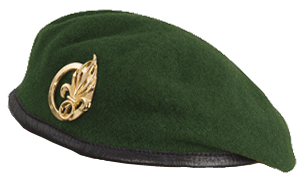
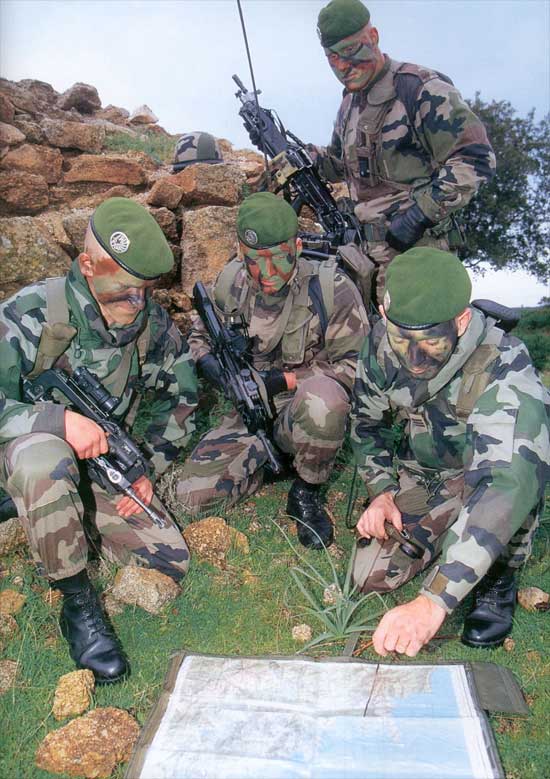
French Navy commandos wear the green beret. 
The French Marines wear dark blue berets. 
French Air Force commandos wear dark blue berets.
French paratroopers wear red berets.
German airborne troops wear maroon berets.
German special forces (KSK) wear berets of the same color, but with a different emblem.

They wear a large black beret.
The Dutch Royal Marines wear dark blue berets.

The Airmobile Brigade (11 Luchtmobiele Brigade) of the Royal Netherlands Armed Forces wears maroon berets (Maroon).

The Finnish Marines wear green berets.
Italian paratroopers of the Carabinieri regiment wear red berets.
Soldiers of the special unit of the Italian Navy wear green berets.

The Portuguese Marines wear dark blue berets.

Soldiers of the British Parachute Regiment wear maroon berets.
Paratroopers of the 16th Air Assault Brigade of the British Army wear the same beret, but with a different emblem.
Special Air Service (SAS) commandos have worn tan berets since World War II.

The British Royal Marines wear green berets.
Canadian paratroopers wear maroon berets.

The 2nd Australian Army Commando Regiment wears green berets.



The American Green Berets (United States Army Special Forces) naturally wear green berets, which were approved for them in 1961 by President John F. Kennedy.


US Airborne troops wear maroon berets, which they received in 1943 from their British counterparts and allies.


But the United States Marine Corps (USMC) does not wear berets. In 1951, the Marine Corps introduced several types of berets, green and blue, but they were rejected by tough warriors due to the fact that they looked “too feminine.”

Georgian Army Special Forces wear maroon (Maroon) berets.
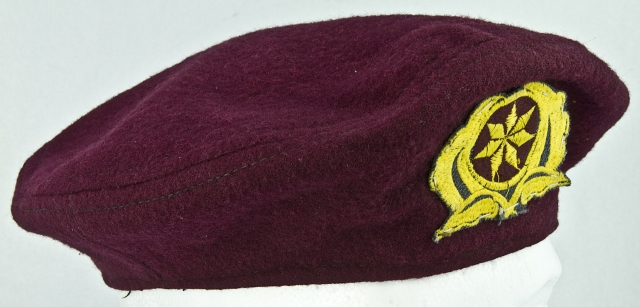
Serbian special forces soldiers wear black berets.

The air assault brigade of the Armed Forces of the Republic of Tajikistan wears blue berets.
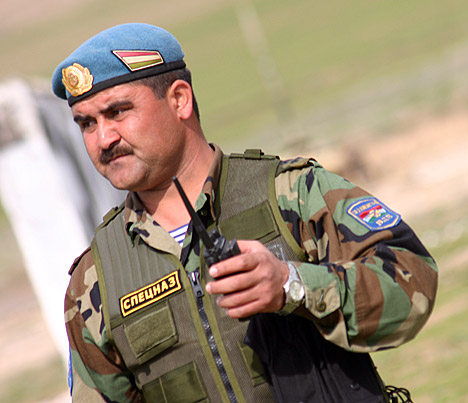
Hugo Chavez wears the red beret of the Venezuelan Parachute Brigade.

Let's move on to the valiant elite troops of Russia and our Slavic brothers.
Our response to the appearance in the armies of NATO countries of units that wore berets, in particular units of the US Special Forces, whose uniform headdress is a beret Green colour, was Order of the Minister of Defense of the USSR dated November 5, 1963 No. 248. According to the order, a new field uniform clothing for special forces units of the USSR Marine Corps. This form was accompanied by a black beret, from cotton fabric for sailors and sergeants of conscript service and woolen fabric for officers.
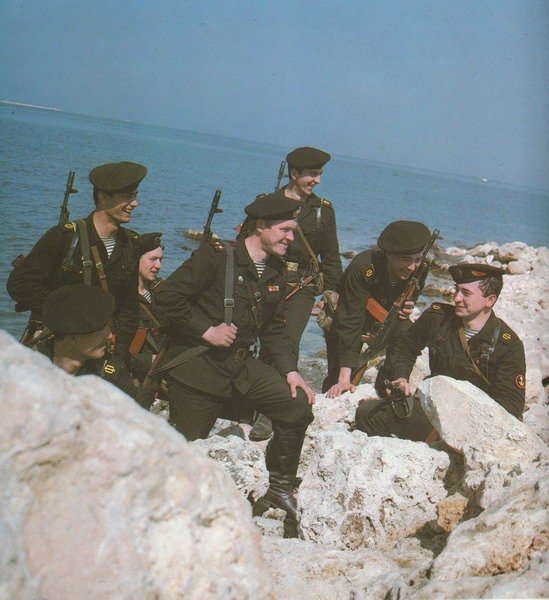
The cockades and stripes on the berets of the Marine Corps changed many times: replacing the red star on the berets of sailors and sergeants with a black oval-shaped emblem with a red star and a bright yellow border, and later, in 1988, by order of the USSR Minister of Defense No. 250 of March 4, the oval emblem was replaced by an asterisk bordered by a wreath. There were also many innovations in the Russian army, and now it looks like this:

After the approval of a new uniform for marine units, berets also appeared in the airborne troops. In June 1967, Colonel General V.F. Margelov, then commander of the Airborne Forces, approved sketches of a new uniform for the airborne troops. The designer of the sketches was the artist A. B. Zhuk, known as the author of many books on small arms and as the author of illustrations of the SVE (Soviet Military Encyclopedia). It was A.B. Zhuk who proposed the crimson color of the beret for paratroopers. A crimson beret was at that time all over the world an attribute of belonging to the airborne troops, and V. F. Margelov approved the wearing of a crimson beret airborne troops, during parades in Moscow. On the right side of the beret was sewn a small blue triangular flag with the emblem of the airborne troops. On the berets of sergeants and soldiers, there was a star framed by a wreath of ears of corn on the front; on the berets of officers, instead of a star, a cockade was attached.

During the November 1967 parade, the paratroopers were already dressed in new uniform and raspberry berets. However, at the very beginning of 1968, instead of crimson berets, paratroopers began to wear blue berets. According to the military leadership, the color of the blue sky is more suitable for airborne troops, and by order No. 191 of the USSR Minister of Defense dated July 26, 1969, a blue beret was approved as a ceremonial headdress for the Airborne Forces. Unlike the crimson beret, on which the flag sewn on the right side was blue, on the blue beret the flag became red.
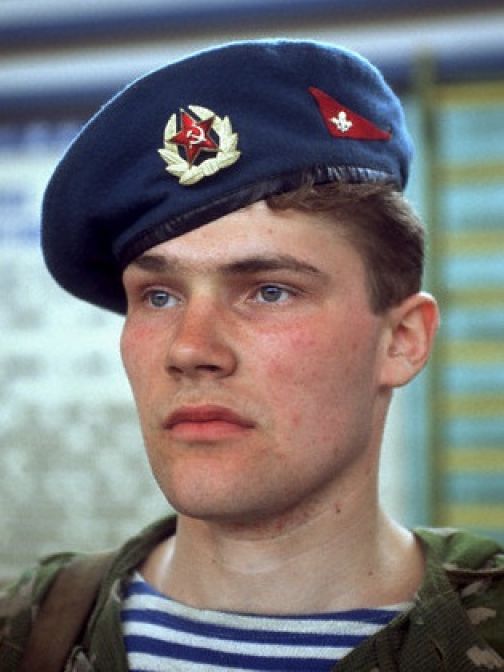
And a modern, Russian version:

GRU special forces soldiers wear airborne uniforms and, accordingly, blue berets.

Special forces units of the internal troops of the Russian Ministry of Internal Affairs wear a maroon (dark red) beret. But unlike other branches of the military, such as marines or paratroopers, among the special forces of the Ministry of Internal Affairs, the maroon beret is a qualification mark and is awarded to the soldier only after he has undergone special training and proven his right to wear a maroon beret.
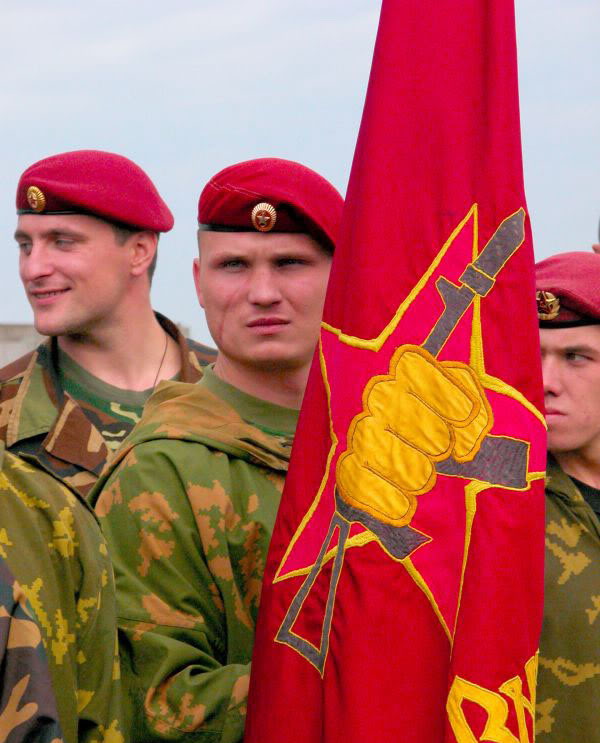

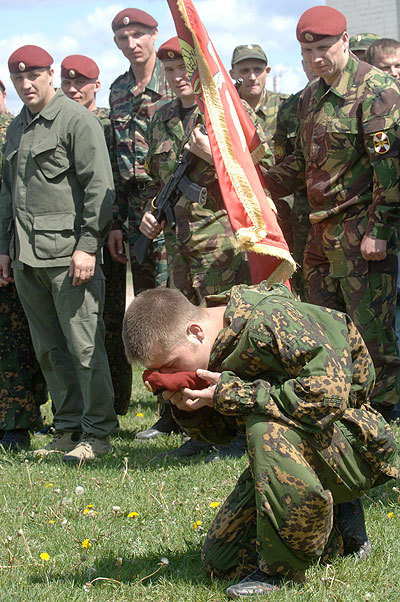
Until received maroon beret special forces soldiers wear khaki berets
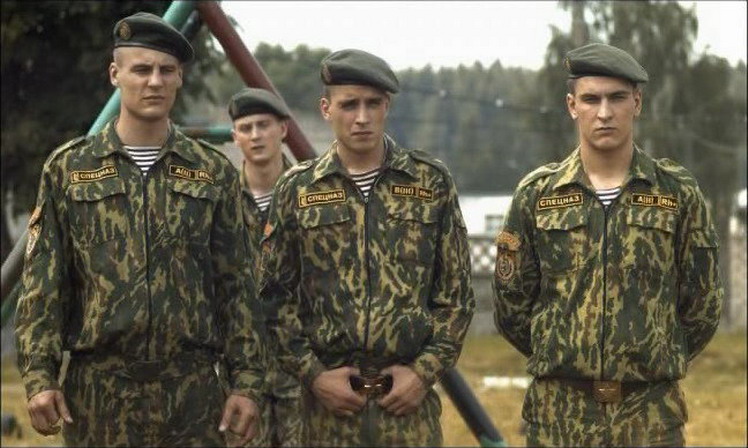
Internal Troops reconnaissance soldiers wear a green beret. The right to wear this beret must also be earned, just like the right to wear a maroon beret.

Our Ukrainian brothers are also heirs of the USSR, and therefore retained the beret colors previously used in this country for their elite units.
The Ukrainian Marine Corps wears black berets.

Ukrainian airmobile troops wear a blue beret.

On August 2, Russia celebrates Airborne Forces Day. As always, groups in vests and blue berets will try to find mutual language with the police and go swimming in the fountains. A religious procession and a festive concert are planned in Moscow.
Paratroopers are often called the elite of the army. On the criteria of elitism in general, applicable to Soviet and Russian army, and the airborne troops in particular are discussed by experts interviewed by Radio Liberty.
Military observer Alexander Golts considers the definition of “elite troops” to be purely subjective:
Eliteness is determined, first of all, by the severity of selection into the troops and the skills possessed by the serviceman of these troops. By definition, elite troops cannot be massive. An example is the Marine Corps. For Russia, where there are only a few marine brigades, these are, of course, elite troops.
The Soviet Union also, of course, had elite troops. This applied to the above-mentioned intelligence units, marines, airborne troops and special forces brigades of the Main Intelligence Directorate.
Many films were made about the airborne troops in the Soviet Union, which made many boys want to serve in the Airborne Forces. However Chief Editor website "Agentura.ru" Andrei Soldatov says that the real elite had no direct connection to the landing:
IN Soviet time there was a big difference between special forces and airborne forces. And even if special forces officers were trained at the Ryazan Airborne School, it was still a separate course. It has always been cultivated among paratroopers physical strength- all these broken bricks, big biceps, vests. And the special forces always looked down on this somewhat. The special forces recruited mostly people who were small in stature and rather fragile, who treated flaunting their physical power not only with contempt, but with a smile. The special forces valued intelligence, the ability to plan some daring actions, and not brute physical strength. And the formation of the famous 45th Special Forces Regiment as part of the Airborne Forces is a new phenomenon that has appeared in the Russian army.
Artem Sheinin, a television journalist working in a senior position in one of the largest Russian television companies, talks about his paratrooper past. In the mid-80s, he was drafted into the Airborne Forces, ended up in Afghanistan, and fought in an airborne assault battalion. In the Armed Forces of the USSR, Artem Sheinin, wearers of blue vests and berets were truly the elite, including due to the fact that they were looked after in advance:
On a national scale, there was a system of pre-conscription, pre-army training of people for service in the Airborne Forces. This was a widespread practice. WITH for the most part We met those people with whom I was later in Fergana back in February 1984. I was drafted in April 1984, and in February 1984 we jumped at the Volosov airfield in the Moscow region.
Everything that is happening to the Russian army now does not correspond to my idea of a combat-ready army. It is difficult for me to judge the state of aviation and the Strategic Missile Forces, but I know for sure that it is impossible to raise a normal Airborne Forces fighter in a year of service, even if during this year, as they say, he will not be engaged in kitchen assignments or household chores. I know quite a lot of people from big cities who are for Lately served in the army and were drafted into the Airborne Forces. But I have not heard anything about how now, as in Soviet times, military registration and enlistment offices would organize the mass transportation of those conscripted into the Airborne Forces for training jumps.
Nevertheless, Artem Sheinin is confident that the landing force still remains the elite of the Russian army, if only because of the tasks for which these units are prepared. Artem says this with the hope that in real life the order to carry out such tasks will never come.
Each element is assigned a number of special functions, which, in general, guarantee full-fledged defense capability. But, as in most other structures, there are privileged, elite units where every fighter dreams of getting into.
The army fulfills its duties not only in the military, but also in Peaceful time, because she must be in good shape all the time.
The classic version of this rather large industry is divided into:
- naval;
- air force;
- land.
Particularly developed countries such as Russian Federation, also have space forces.
Special elite troops do not belong to the public division. Getting there is considered prestigious, not only due to the mass of advantages for employees, but the very status of such a soldier will say a lot about him, even to a civilian.
What does “elite” mean when it comes to troops?
This stable concept is not thoroughly understood by everyone. The first thing that comes to mind when you hear the name “Russian Elite Troops” is something incredibly terrifying and powerful. These are the most experienced masters of their craft, professional warriors. But it's not that simple.
Being a completely journalistic name, it has no legislative basis and is not secured in any way at all. A popular expression that has taken on prohibitive national scale and nothing more.
Therefore, it is impossible to call it elite by singling out any single structure of the armed forces. There is no single evaluation criterion by which to determine the status of specific troops.
In fact, based on the fact that the expression was invented by the people, the rating of warriors who are considered supposedly elite is chosen by the same population of the state.
Surveys of this kind are conducted primarily to identify the most combat-ready unit. Additionally, elite status is granted to troops who demonstrate heroic deeds or highly professional skills during various types of tasks from the state.
In this article we will look at the generally accepted list of elite troops, and how likely it is to get there.
FSO
The department, which appeared thanks to the internal traditions of the country, has existed since the founding of the notorious 9th Department of State Security of the USSR.
Nowadays, conscript soldiers are recruited there. The most prestigious unit in this industry is considered the Presidential Regiment, which annually includes 240 conscripts according to a very strict selection principle. It is not enough to have excellent physical fitness and the appearance of the average Slav, but if you are under 180 cm tall, your path there is already closed.
Among novice military personnel who plan to devote their lives to serving the security of the Motherland, getting into the Presidential Regiment means opening a “green path” to the SOP of the Russian Federation, and this is nothing less than the protection of the most significant person in the country - its guarantor.
Space Force
 The possibility of non-contact armed confrontation has become practically a necessity in the 21st century. The Space Force is the crown of evolution on this moment and is developing every hour. The key role of this industry is to protect the territory of the state entrusted to the unit from space attack using nuclear warheads or other innovative weapons.
The possibility of non-contact armed confrontation has become practically a necessity in the 21st century. The Space Force is the crown of evolution on this moment and is developing every hour. The key role of this industry is to protect the territory of the state entrusted to the unit from space attack using nuclear warheads or other innovative weapons.
Serve in space force ah, it’s not just prestigious - it’s a big step into the future, which will certainly be endless, like space. But how safe it is depends directly on the specialists themselves who serve there. Why not warriors? Because there is no educational institution in Russia that prepares people for service in the Space Forces. Personnel are recruited there from the most prestigious technical universities of the Federation.
Marines
The previously mentioned troops are not as wildly popular as the Marines among conscripts and military professionals. The Russian Navy is the most combat-ready and lethal unit of the entire structure. On given time it consists of five fleets:
- Northern;
- Pacific;
- Caspian;
- Black Sea;
- Baltic.
To get into their ranks, you must successfully pass two stages of verification on a competitive basis:
- During distribution at the military registration and enlistment office, undergo a special selection into the ranks of recruits for the naval forces.
- Prove yourself while serving in the navy with best side as a strong-willed, decisive and strong person with excellent physical health and a developed body, be ready to make morally difficult decisions.
It is at the second stage that most recruits are eliminated, because not everyone can handle the enormous physical and psychological stress.
The well-being of absolutely any state directly depends on the national army. The more combat-ready it is, the fewer threats there will be to the country's security. But one should understand the fact that the army is a systemic concept that has internal features and specific structural components. Each of these elements is assigned a number of specific functions necessary to ensure the defense capability of the state. It must also be remembered that the army performs important tasks both in war time, and in peaceful times. In the classic version, it consists of several main elements, namely: naval, ground, and air forces.
In especially developed countries there are other troops, for example, in the Russian Federation there are space troops. Secretly, special elite troops are allocated, which are assigned special functions. It is these national military formations of the Russian Federation that will be discussed in the article below.
The essence of the concept
What are Russia's elite troops? Many people do not even understand the meaning of this stable phrase. Elite troops represent any separate part of the clan (company, division, battalion, etc.). The peculiarity is that this part of the national army is in a higher degree of combat readiness than the other components armed forces.
“Elite troops” is entirely a journalistic expression. It is not enshrined in any way at the legislative level. Thus, it is possible to single out any elite troops of Russia from the entire array of the armed forces of the Russian Federation purely nominally. To date, there are no specific evaluation criteria according to which one could determine the eliteness of certain troops.
Basis for determination
As stated earlier, Russia’s elite troops are not determined at the legislative level. Most often, ratings are created or surveys are conducted to determine the most combat-ready troops, according to the population of the Russian Federation. Also, an “elite” degree can be given to an army or unit for demonstrated heroism or professionalism when performing any combat missions or for other services to the state. Below we will look at a list of Russia's elite troops, which is generally recognized.
Federal Security Service
This department has internal traditions that have existed since the existence of the 9th department State Security THE USSR. Today, conscript soldiers are being recruited for service. The most prestigious unit of the FSO is the Presidential Regiment. About 240 conscripts undergo military service annually. The selection is quite strict.

You must have excellent physical fitness Slavic appearance and a height of at least 180 centimeters. It is believed that the Presidential Regiment is a springboard, after which a direct path to the Security Service of the President of the Russian Federation opens.
Space Forces of the Russian Federation
At the dawn of the 21st century, the question arises about the need to conduct non-contact warfare. Space Forces are the crown of evolution. Today they are at the very first stage of their development, however, they are developing literally by the hour. The main task of the space forces is to protect the territory of the state from attack from space through nuclear missiles or other innovative weapons.  At the moment, there are no special educational institutions in Russia that train specialists for these troops. Personnel are recruited from the most prestigious technical universities in Moscow.
At the moment, there are no special educational institutions in Russia that train specialists for these troops. Personnel are recruited from the most prestigious technical universities in Moscow.
Marines
The elite troops of Russia, the names of which were presented above, do not enjoy such wild interest among conscripts and military specialists as the Russian Marines. Its units belong to the naval forces of the Russian Federation.

They are the most combat-ready and deadly. Today it includes five fleets: the Black Sea, Caspian, Northern, Pacific and Baltic. To get into the ranks of the Marines, you need to go through two competitive stages. Firstly, even during the distribution at the military registration and enlistment office, you will need to undergo a special selection for the team of recruits for the Marine Corps forces. Secondly, directly in the navy you need to prove yourself as a strong and strong-willed person, because morally stable and physically healthy people are accepted into the ranks of the Marine Corps.
Strategic Missile Forces
They have unprecedented popularity for strategic purposes. They have certain tasks and functions that, in fact, do not exist in other military formations of the Russian Federation.  It should be noted right away that missile forces are entirely sedentary work in a bunker or on a military base. However, a person with exceptional abilities in the fields of mathematics and physics can get here. Conscripts are practically not involved. Basically, strategic missile forces gather officers under their command.
It should be noted right away that missile forces are entirely sedentary work in a bunker or on a military base. However, a person with exceptional abilities in the fields of mathematics and physics can get here. Conscripts are practically not involved. Basically, strategic missile forces gather officers under their command.
Today, the Russian Federation has about six types of military missile systems. You should understand the fact that missile forces are the main striking force. Modern installations can literally tear almost any country in the world to pieces in a matter of seconds.
Rocket Forces- This is the pride of our country. They are singled out from the entire array, like other elite Russian troops. The rating of professional military formations of the Russian Federation does not end there. For many years now, the most combat-ready and mobile troops have held the palm. They are described below.
Airborne troops
In many countries of the world there are no airborne troops. They are simply not singled out. Units of this type are distinguished in For example, in America there is a Navy SEAL unit, which is assigned to the US Navy. But in our country airborne troops, or Airborne Forces, as they are commonly called, are the most elite troops in Russia. Representatives of the “blue berets” participated in almost all conflicts in which the Russian Federation was one of the parties. Airborne troops conduct their activities behind enemy lines. Therefore, they are considered the most mobile and efficient. There are also special forces airborne troops.

To get into the most elite troops in Russia, you need to train hard and for a long time. Many experts advise starting physical training even before the offensive. Both conscripts and officers who graduated from special universities enter the Airborne Forces. Knowledge of any martial arts or military sports training is welcome. This branch of the military is the most promising in the Russian Federation, because it recruits personnel for the GRU, FSB and other secret special forces units.
Conclusion
We looked at Russia's elite troops. Please note that this list may change over time. Nevertheless, the rating is based on facts of combat effectiveness and detailed surveys of the population. The article also answers the question of how to get into Russia's elite troops. In conclusion, we add that the army is the destiny of the strong and purposeful people. If you are one hundred percent confident in yourself, then the elite of the Russian Armed Forces is waiting!
- Mackerel in oil in a slow cooker: a recipe for preparing delicious canned food for the winter
- Red currants pickled for the winter
- Masago caviar: what it is, where it is used, description and nutritional value
- Bonus – a completely new apple pie recipe – French apple pie “Tarte Tatin”
- Minced meat cakes in the oven
- Step-by-step cooking instructions
- Christmas fortune telling for children
- Sergey Yesenin Yesenin's work more information
- Ancient Slavic calendar Daaryan circle number of the god Kolyada dar Slavic Vedic calendar
- Slavic fabric amulets dolls: their meaning and how to make them with your own hands When you need to say goodbye to a doll
- Festive cutting of dough
- Step-by-step recipe for making pies with potatoes in the oven
- Oven pies with potatoes
- Recipes for simple and tasty salads with croutons
- Recipes for simple and tasty salads with croutons
- Fish soup Sea bass recipes for cooking fish soup
- Chicken hearts in sour cream
- Chicken hearts in sour cream: recipes
- Recipe for lavash envelopes with cheese
- Preparation of canned fish from mackerel









